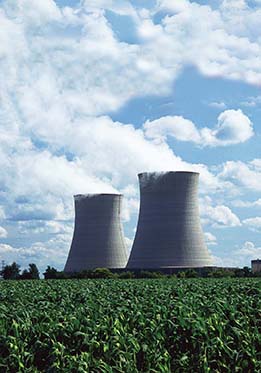American Issues  Connector: Technology and Society
Connector: Technology and Society

Nuclear power plant, Illinois
TRACK THE ISSUE
![]() Checkpoint What are the benefits and costs of technology?
Checkpoint What are the benefits and costs of technology?
Technology has had a great impact on American life. It has brought economic and social benefits for the nation, yet it has also had some negative effects. What are the benefits and costs of technological change? Use the timeline below to explore this enduring issue.
-
Late 1700s Factory System
Water-powered mills boost production but worsen conditions for workers.
-
1859 Oil Refining
Oil fuels industrial growth and raises standard of living but encourages American dependence on a single resource and worsens pollution.
-
1930s Polymers
Manufactured materials like plastics have many uses but also increase pollution.
-
1940s Nuclear Reactor
Nuclear energy holds promise but carries the threat of radioactive meltdown and nuclear waste.
-
2000s Genetic Engineering
Biotechnology offers benefits but may also have harmful effects.

Factory workers circa 1900
DEBATE THE ISSUE
Nuclear Energy Building more nuclear plants would help meet our energy needs and limit fossil-fuel emissions that contribute to global warming. But the radioactive material they produce may pose grave risks to human health and safety.
“Nuclear energy supplies clean, reliable, affordable and safe electricity and is the only emission-free source that can be readily expanded to meet our nation’s growing energy needs…. Nuclear power plants produce electricity that otherwise would be supplied by oil-, gas-, or coal-fired generating capacity, and thus prevent the emissions associated with that fossil-fueled capacity.”
—John E. Kane, Senior Vice President, Nuclear Energy Institute
“There is strong skepticism … [about] the promises of the nuclear industry…. This is an industry that on a daily basis, as a direct result of its work, generates the most toxic and long-lived substances known to humans. It is an industry that poses a grievous threat to the health of humans and to the wider biosphere.”
—Dave Sweeney, nuclear campaigner, Australian Conservation Foundation
 TRANSFER Activities
TRANSFER Activities
- Compare Why does Mr. Kane support nuclear energy? Why does Mr. Sweeney oppose it?
- Analyze Which of the authors cited here would be more likely to question the factory system’s impact on workers?
- Transfer Use the following Web site to see a video, try a WebQuest, and write in your journal. Web Code: neh-7302




